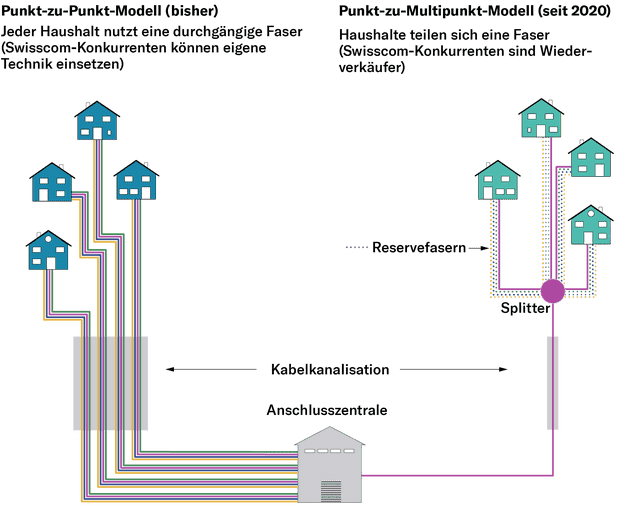The telecom group suffers the next defeat in the fiber optic dispute. The decision to prevent Swisscom from using a technology as a precaution was permissible.
Swisscom’s appeal to the Federal Supreme Court was dismissed.
Does Swisscom have to use a “luxury variant” when expanding the fiber optic network? Or does the telecom group’s preferred but controversial “cheap version” do the trick? To put it radically simplified, the glass fiber dispute revolves around this question.
In order to clarify the matter calmly, the Competition Commission (Comco) ordered a march stop in December 2020. She ordered precautionary measures against Swisscom. Since then, the group has been allowed to continue building according to the “cheap variant” model. However, Swisscom is not allowed to put the corresponding fiber optic connections into operation.
In a decision published on Tuesday evening, the Federal Supreme Court rejected an appeal by Swisscom against the precautionary measures. The judges in Lausanne are thus supporting a judgment of the Federal Administrative Court of September 2021, which in turn had confirmed the Weko order.
The dispute has not yet been resolved
The decision of the Federal Supreme Court refers to the “sideshow” of the precautionary measures. It only checked whether the confirmation of the Weko measures by the Federal Administrative Court was correct. That is the case in the eyes of the federal court.
It was to be expected that the Federal Supreme Court would not lift the precautionary measures. The hurdles for correcting a decision of the lower court are high in such cases.
In their summary examination, the Lausanne judges came to the conclusion that it was not obviously untenable to order the precautionary measures based on the Cartel Act. They also reject the accusation of arbitrariness brought by Swisscom to the Federal Administrative Court.
The main procedure is still stuck at the Weko. It has not yet been clarified whether Swisscom will definitely have to build the fiber optic network with the “luxury variant”. The Weko should not make a decision until next year.
No criticism of the verdict
Swisscom responded to the verdict on Tuesday evening with a communiqué. Take note of the verdict, it says simply. The telecom group is thus breaking with a tradition: Swisscom was previously known for criticizing the decisions of Weko or the courts. She doesn’t do that this time.
That may be a coincidence. But it can also be the handwriting of the new CEO Christoph Aeschlimann. He may have come to the conclusion that nagging about decisions by the competition authority or the courts is rather counterproductive.
As early as October, Swisscom announced that in the future it would largely expand the fiber optic network again in the “luxury version” permitted by ComCo. The group had previously continued to build connections with the “cheap version” despite the precautionary measures taken by Weko.
It wasn’t forbidden, but it was risky. Swisscom was aware that the connections must not be put into operation as long as the precautionary measures are in place. This is another reason why around 400,000 fiber optic connections are blocked in Switzerland today.
Cost versus competition
Why is ComCo interested at all in how Swisscom builds its fiber optic network? The other Internet providers are dependent on the network of the ex-monopolist. In many places they can only offer their services via the Swisscom infrastructure.
With the “luxury variant”, the so-called point-to-point architecture, you can use your own hardware to illuminate a fiber optic cable rented from Swisscom. Internet providers have maximum leeway when designing their offers, for example in terms of speed.
Until 2020, Swisscom relied on the “luxury variant”. Only then did the group switch to the “cheap version”. This so-called point-to-multipoint architecture has also become established in many other countries. Fewer fiber optic cables need to be laid for this type of construction. According to Swisscom, this reduces costs because less civil engineering work is required.
However, small Internet providers can no longer use their own devices with the “cheap version”. There simply aren’t enough fiber optics for that. You therefore have to rent a standardized preliminary product. Swisscom sets the framework with its technology. From ComCo’s point of view, this endangers effective competition.
Judgment 2C_876/2021 of November 2, 2022

